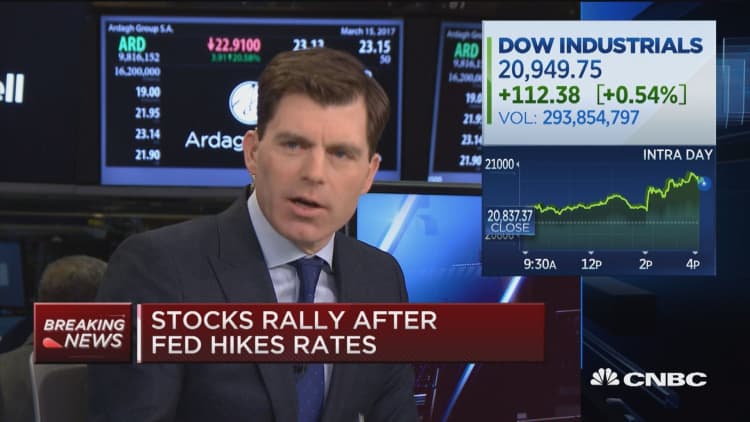
U.S. stocks closed higher Wednesday, helped by a bounce in oil prices, after the Federal Reserve took a less aggressive stance than expected. The central bank did raise interest rates, as expected.
The Dow Jones industrial average closed up about 110 points following the statement release. UnitedHealth contributed the most to gains, followed by Johnson & Johnson and Caterpillar.
The Nasdaq 100 hit a fresh intraday high and closed at a record, helped by record highs in Apple shares. Semiconductor stocks also reversed earlier losses, with the iShares PHLX Semiconductor ETF (SOXX) ending nearly 0.8 percent higher.
"Most people were expecting a much more hawkish statement," said Diane Swonk of DS Economics. "The dissent along with the waffling language on inflation, even though the economic language was strong," indicated continuation of gradual policy, she said.
The Fed raised the target range for the federal funds rate to 0.75 percent to 1 percent. Minneapolis Fed President Neel Kashkari had the only "no" vote.
In a statement, policy makers said they expect labor market conditions to "strengthen somewhat further" and inflation to "stabilize around 2 percent" in the near-term.
Treasury yields fell after the statement release. The dropped to 1.30 percent, its lowest in a about week. Earlier in the session, the yield hit a high of 1.401 percent, its highest since June 11, 2009. The 10-year yield traded around 2.50 percent, also its lowest in roughly a week.
"It was a little bit of a relief rally in bonds. ... There was some nervousness the Fed would be a little more aggressive than suspected," said Bryce Doty, senior fixed income manager with Sit Investment Associates.
However, he expects "this decline in yields is going to be short-lived. If the Fed just raises rates two times [this year], there's no way the two-year yield could be at 1.32 percent."
The U.S. dollar index extended losses to trade more than 1 percent lower at levels not seen in more than two weeks. The euro traded around $1.073 and the yen near 113.4 yen against the greenback.
Financial stocks were the only decliner in the S&P 500. The energy sector led advancers, closing up nearly 2.1 percent as oil reversed a seven-day losing streak. U.S. crude oil futures settled up 2.39 percent at $48.86 a barrel after weekly crude inventory data showed a drawdown in stockpiles.
In economic news, the consumer price index rose 0.1 percent in February for a 2.7 percent increase over the last 12 months, the biggest year-on-year gain since March 2012, Reuters said. Ex-food and energy costs, the so-called core CPI rose 2.2 percent in the 12 months through February.
"I don't think inflation will move up very rapidly from here but it's clear inflation is steadily moving up," said David Kelly, chief global strategist at JPMorgan Asset Management.
Retail sales posted a 0.1 percent rise last month, the weakest print since August, according to Reuters. Excluding automobiles, gasoline, building materials and food services, the so-called core retail sales rose 0.1 percent after an upwardly revised 0.8 percent jump in January.
Both CPI and retail sales mostly matched expectations.
The Empire State Manufacturing Index edged lower to 16.4 for March. The new orders index climbed eight points to 21.3, its highest level since 2009, according to the New York Fed.
A separate report showed home builder sentiment hit 71 in March, its highest in 12 years.
Business inventories rose 0.3 percent in January.
Major U.S. Indexes
Traders also watched Wednesday's general elections in the Netherlands for any indication on the strength of populist sentiment.
The STOXX Europe 600 gained 0.44 percent. The Shanghai composite closed up 0.08 percent, while the Nikkei 225 fell 0.16 percent.
The Dow Jones industrial average closed up 112.73 points, or 0.54 percent, at 20,950.10. Caterpillar was the greatest advancer, while American Express was the greatest laggard.
The S&P 500 closed up 19.81 points, or 0.84 percent, at 2,385.26. Energy was the top advancer, while financials were the only decliner.
The Nasdaq composite gained 43.23 points, or 0.74 percent, to 5,900.05.
The CBOE Volatility Index (VIX), widely considered the best gauge of fear in the market, fell to trade near 11.6.
About nine stocks advanced for every decliner on the New York Stock Exchange, with an exchange volume of 913 million and a composite volume of nearly 3.9 billion in the close.
Composite trade volume was the highest since March 1.
Gold futures for April delivery settled down $1.90 at $1,200.70 an ounce.
On tap this week:
Thursday
Earnings: Adobe Systems, Dollar General, JA Solar, Vivant Solar
8:30 a.m. Jobless claims
8:30 a.m. Housing starts
8:30 a.m. Building permits
8:30 a.m. Philadelphia Fed survey
10:00 a.m. JOLTS
Friday
Earnings: Tiffany
9:15 a.m. Industrial production
9:15 a.m. Capacity utilization
10:00 a.m. Consumer sentiment
*Calendar subject to change.


